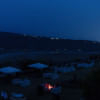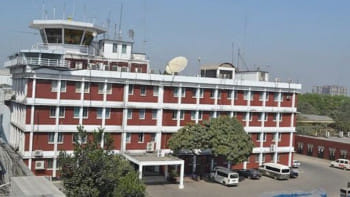US stepped in as India-Pakistan conflict raised nuclear fears: NY Times report

As conflict between India and Pakistan escalated, United States Vice President JD Vance told Fox News on Thursday that it was "fundamentally none of our business".
The United States could counsel both sides to back away, he suggested, but this was not America's fight.
However, within 24 hours, Vance and Marco Rubio -- serving his first week in a dual role as national security adviser and secretary of state -- were deeply involved in the issue. The reason, according to The New York Times, was a familiar one: fear that the conflict could quickly escalate to nuclear levels.
What compelled the Trump administration to act was intelligence suggesting the Pakistani and Indian air forces had begun serious aerial skirmishes, and Pakistan had reportedly sent 300 to 400 drones into Indian airspace to test its air defense systems.
But the greatest concern came late Friday, when explosions struck Nur Khan Air Base in Rawalpindi, a city adjacent to Islamabad. The base is a critical facility, housing Pakistan's air refuelling operations and serving as a central transport hub for its military. Importantly, it is located near the headquarters of Pakistan's Strategic Plans Division, which manages the country's nuclear arsenal -- believed to consist of around 170 warheads.
The armed conflict between the two neighbours flared up after a deadly terrorist attack on April 22 in Kashmir, a contested region claimed by both countries, which left 26 people -- mostly Hindu tourists -- dead. On Saturday morning, US President Donald Trump announced that both India and Pakistan had agreed to a ceasefire.
A former US official familiar with Pakistan's nuclear programme said on Saturday that Islamabad's biggest fear is a decapitation strike on its nuclear command authority. The strike on Nur Khan, the official noted, may have been perceived as a warning that India could target this command structure directly.
Although it remains unclear whether US intelligence pointed to an imminent nuclear escalation, The New York Times reported that the only public indication of nuclear signalling came from Pakistan. Local media stated that Prime Minister Shehbaz Sharif had convened a meeting of the National Command Authority -- the high-level body responsible for nuclear decision-making.
The authority, established in 2000, is officially chaired by the prime minister and includes top civilian and military leaders. However, in practice, it is largely driven by the army chief, currently Gen Syed Asim Munir.
Pakistan's Defence Minister Khawaja Muhammad Asif denied that the authority had met. Speaking on Pakistani television on Saturday, before the ceasefire was announced, he acknowledged the existence of the nuclear option but added: "We should treat it as a very distant possibility; we shouldn't even discuss it."
Despite that public stance, the matter was reportedly under serious discussion in Washington. By Friday morning, the White House concluded that mere statements and phone calls to Islamabad and New Delhi were insufficient. Diplomatic interventions from Saudi Arabia and the UAE had minimal impact.
Speaking to Fox News, Vance said, "We're concerned about any time nuclear powers collide and have a major conflict." He added, "What we can do is encourage these folks to de-escalate a little bit."
According to The New York Times, people familiar with the situation said concern within the US administration spiked after the Fox News interview, as the pace of airstrikes and counterstrikes escalated. Initially, India targeted militant camps allegedly linked to Lashkar-e-Taiba, blamed for the Kashmir attack. But it then began hitting Pakistani military installations.
There was also worry in Washington that messages urging restraint were not reaching the highest levels of leadership in either country.
It was then decided that Vice President Vance -- who had recently visited India with his wife Usha, the daughter of Indian immigrants -- should call Indian Prime Minister Narendra Modi directly. Vance reportedly told Modi that the United States assessed a high probability of the conflict spiraling into full-scale war.
In the US account, Vance urged Modi to consider alternatives to continued airstrikes, suggesting a diplomatic "off-ramp" that might be acceptable to Pakistan. Modi listened but did not commit to any of the suggestions.
Meanwhile, Rubio contacted Gen Munir. The relationship was reportedly eased by the US's longstanding role as a back-channel to Pakistan's powerful military. Rubio also spoke with Pakistan's Foreign Minister Ishaq Dar and Indian External Affairs Minister S Jaishankar, whom he had met earlier this year in Washington.
The effectiveness of those conversations remains unclear. The US State Department did not hold a press briefing on Saturday, instead issuing brief descriptions that offered little insight into the exchanges. However, The New York Times reported that a continuous flow of calls from Friday night through early Saturday helped lay the groundwork for the ceasefire.
A senior Pakistani intelligence official told the newspaper that US involvement over the previous 48 hours – particularly Rubio's efforts -- was instrumental in securing the truce. Despite the ceasefire announcement, reports of cross-border firing continued into Saturday night.
PM Shehbaz Sharif publicly acknowledged the US role, writing on X (formerly Twitter): "We thank President Trump for his leadership and proactive role for peace in the region. Pakistan appreciates the United States for facilitating this outcome, which we have accepted in the interest of regional peace and stability."
India, however, did not acknowledge any US involvement.
Whether the ceasefire will hold remains uncertain. Pakistan reportedly shot down five Indian aircraft, though Indian officials have not commented on the losses.
According to a senior Pakistani intelligence official, the US assessed that India was attempting to provoke Pakistan into using its US-supplied F-16 fighter jets, hoping to shoot one down. The F-16s were originally provided by the US after it designated Pakistan a "major non-NATO ally" following the September 11 attacks in 2001.
The official added that US intervention was essential in pulling both sides back from the brink. "The last move came from the president," he said.

 For all latest news, follow The Daily Star's Google News channel.
For all latest news, follow The Daily Star's Google News channel. 








Comments